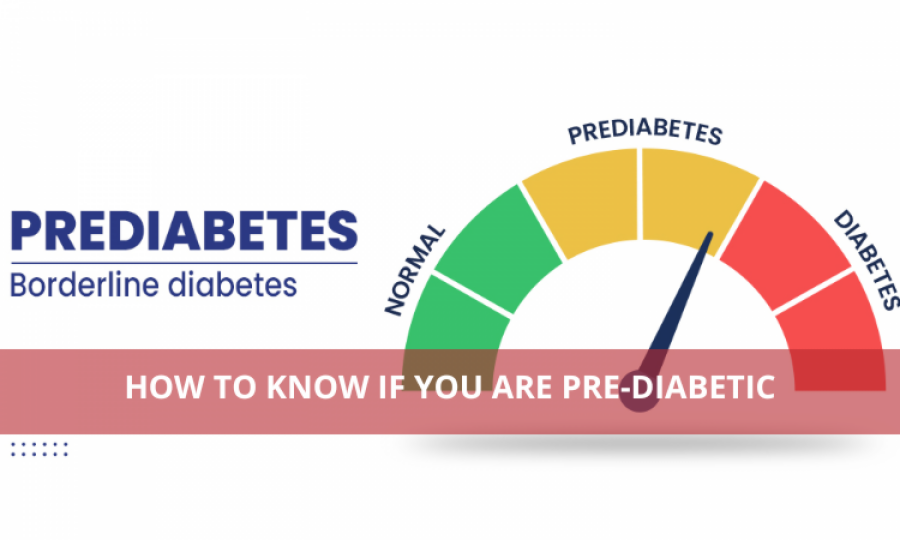How To Know If You Are Pre-Diabetic

Pre-diabetes means a higher-than-normal blood sugar level. This happens because the body is not able to metabolize sugar properly. The causes may include reduced insulin production or insulin resistance. Genetics also play a significant role. While sugar levels in pre-diabetics are not high enough to be diagnosed as type 2 diabetes, it may progress to that if necessary precautions are not taken.
Risk Factors
These factors increase the risk of becoming pre-diabetic or developing diabetes later on:
● Above 45 years of age
● Obesity (more fatty tissue leads to increased insulin resistance)
● Large waist sizes (indicate insulin resistance)
● Family history of diabetes
● Being physically active less than 3 times a week
● History of gestational diabetes (during pregnancy)
● Hypertension
● Low birth weight
● Excessive intake of red meat or processed meat
● Excessive intake of sugary beverages
● Race or ethnicity (Black, Hispanic, American Indian, and Asian American)
● Polycystic ovary syndrome
● Obstructive sleep apnea
● Tobacco smoke
● Low levels of high-density lipoprotein (HDL) cholesterol
● High levels of triglycerides
Signs and Symptoms
Usually, pre-diabetes has no major symptoms or they appear gradually and may go unnoticed. However, some warning signs may include:
● Darkened skin of the neck, armpits, knuckles, knees, or groin
● Increased thirst
● Frequent urination
● Increased hunger
● Fatigue
● Blurry vision
● Numbness or tingling sensations in hands or feet
● Delayed wound healing
● Unintentional weight loss
Complications
Pre-diabetes can lead to long-term damage to the body if it is left unchecked and progresses to type 2 diabetes. This may include the following:
High blood pressure
● High cholesterol
● Cardiac disease
● Stroke
● Kidney disease
● Nerve damage (peripheral neuropathy)
● Fatty liver disease
● Eye damage and vision loss
● Rashes
● Amputation
● Unrecognized (silent) heart attacks
Diagnosis
If any of the above signs and symptoms are occurring within your body, you should get your blood sugar levels tested. Numerous diagnostic tests exist for prediabetes such as:
● Glycated Hemoglobin (A1C) Test
This is the most preferable test that gives the average glucose blood levels for the past 2 to 3 months. A person is diagnosed as a prediabetic if the results show 5.7% to 6.4%. However, it may be inaccurate in some conditions, such as in pregnancy and rare forms of haemoglobin.
● Fasting Blood Sugar Test
Blood is drawn after 8 hours of fasting and milligrams of sugar per decilitre (mmol/L) or millimoles of sugar per litre (mmol/L) are measured. Usually, a level of 100 to 125 mg/dL (5.6 to 6.9 mmol/L) indicates prediabetes.
● Oral Glucose Tolerance Test
This is a less common test which requires the person to fast overnight and drink a sugary liquid at the lab. Blood sugar levels are tested, intermittently, over the next two hours. A level of 140 to 199 mg/dL is diagnosed as prediabetes.
Prevention
Maintaining a healthy lifestyle is the key to preventing the progression of pre-diabetes to type 2 diabetes. This involves:
● Healthy and balanced diet
● Regular exercise
● Controlled blood pressure and cholesterol levels
● Healthy weight
● No smoking
● Limited alcohol intake
Trending
Popular
Sindh pledges vigorous action to prevent poliovirus transmission
-
PMA stresses health equity on World ...
04:08 PM, 9 Apr, 2024 -
Dow University’s new rabies vaccine ...
12:18 PM, 28 Mar, 2024 -
IRD role lauded in advancing ...
02:53 PM, 12 Mar, 2024 -
Over one billion people worldwide ...
09:48 AM, 5 Mar, 2024




